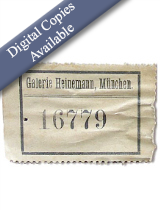
Deutsches Kunstarchiv im Germanischen Nationalmuseum
The Deutsches Kunstarchiv in the Germanisches Nationalmuseum, Nuremberg, is the largest archive of primary documentation relating to German art and culture. Its holdings cover the fine arts in German-speaking countries, with a focus on hand- and typewritten manuscripts as well as personal documents such as letters, and professional records of the careers of artists and art historians as well as art institutions and galleries. In addition to gathering and preserving artists' and art historians' estates in order to catalogue them and make them publicly available, the Deutsches Kunstarchiv is actively engaged in researching its own holdings as the basis for exhibitions, publications and lectures.
The Galerie Heinemann Munich was founded in 1872 by David Heinemann (1819-1902) and was numbered amongst the most important art dealerships in Germany until its Aryanization in 1938. The gallery, which operated internationally, had several branch offices in cities such as Frankfurt am Main, Nice and New York. It specialized in 19th and early 20th century German art, but also dedicated itself to English, French and Spanish art. Altogether it organized approximately 300 solo and thematic group exhibitions between 1880 and 1935.
The Galerie Heinemann project, comprising digitization, data entry and internet presentation of the gallery's documents, is the first major digitization project of German dealer records relevant to the Nazi era. The provision of dealer records online is a significant development in assisting researchers internationally in documenting provenance. The Galerie Heinemann project was developed by the Deutsches Kunstarchiv in cooperation with the Zentralinstitut für Kunstgeschichte, Munich, as well as with the conceptual assistance of Facts & Files, Historisches Forschungsinstitut Berlin (Historic Research Institute). The Arbeitsstelle für Provenienzrecherche/ -forschung (Bureau for Provenance Research and Investigation), Berlin, approved and provided financial support for the project in spring 2009. The Galerie Heinemann internet database was activated on July 29, 2010.
For more information, please visit the Deutsches Kunstarchiv im Germanischen Nationalmuseum.
Return to the home page of the International Research Portal.
